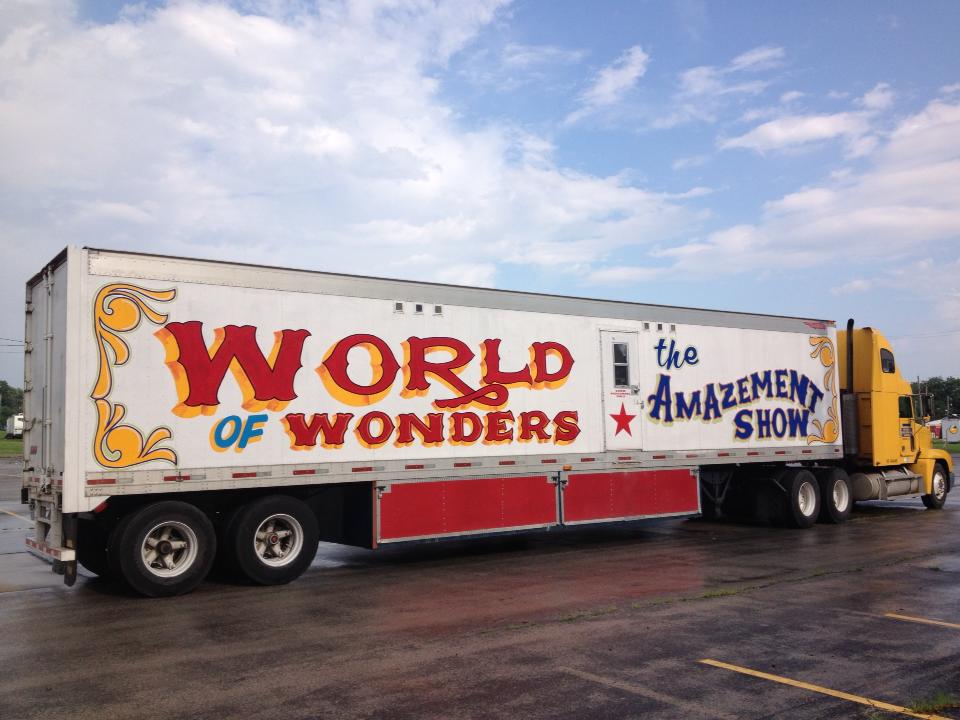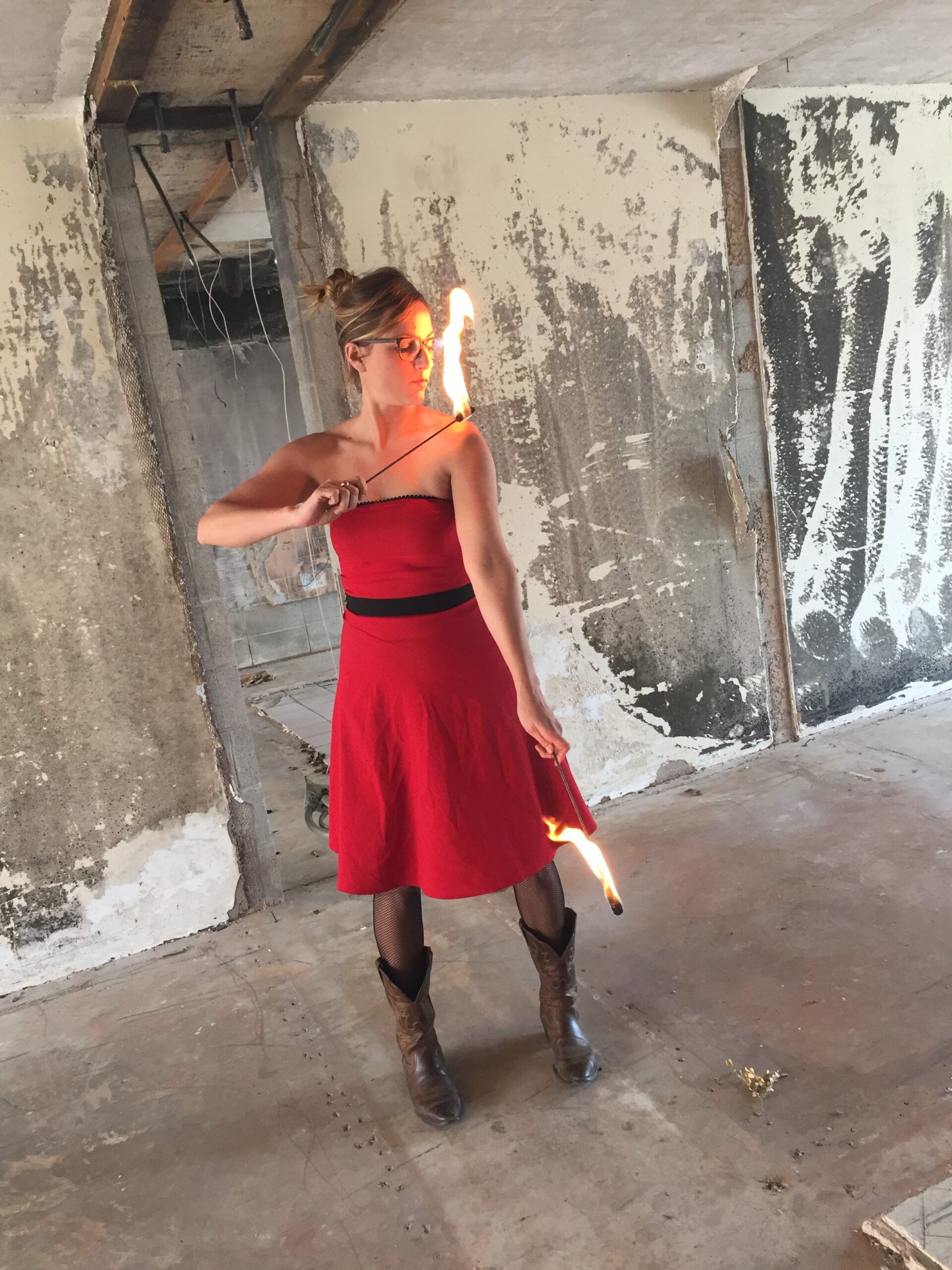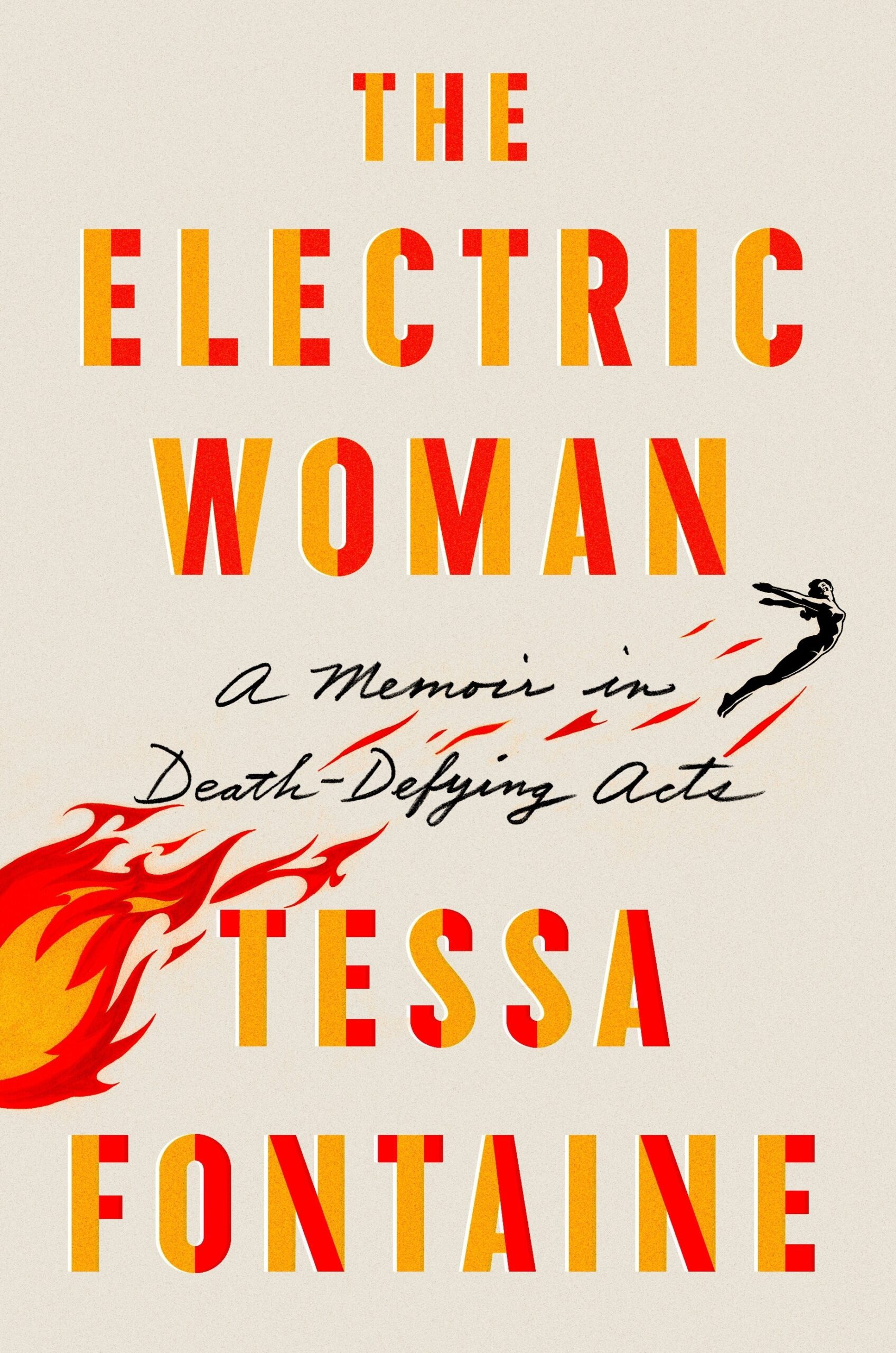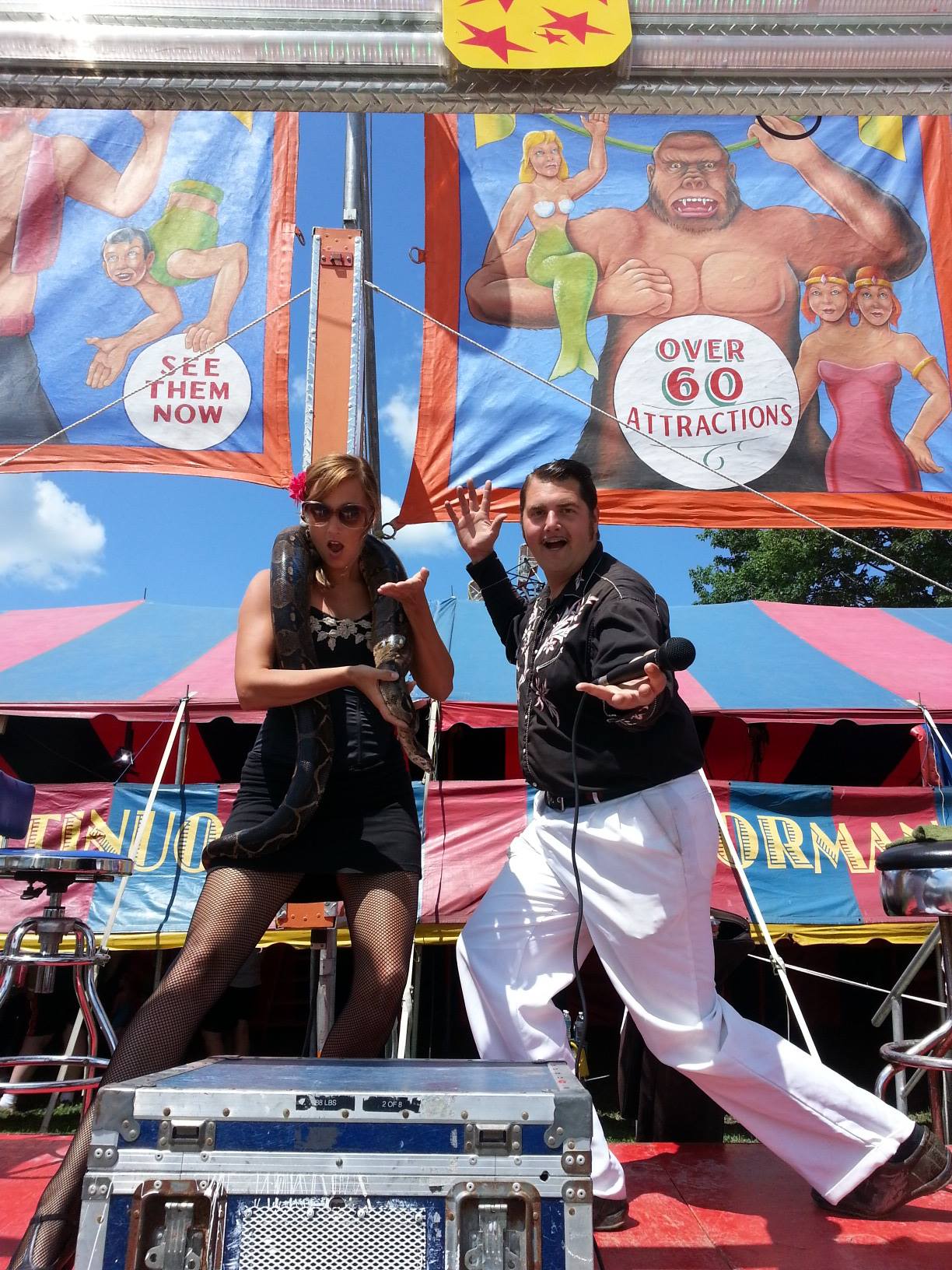
The trick is there is no trick, writes Tessa Fontaine when she learns to eat fire, early on in her debut memoir, The Electric Woman: A Memoir in Death-Defying Acts. But she has pulled off a miraculous trick. Weaving stories of her life as part of America’s last traveling sideshow with the narrative of her mother’s debilitating stroke and slow attempts at recovery, Fontaine has written an incredibly moving account of charting her own course in the unlikeliest of ways.
As someone who loves all things with a whiff of the circus on them, I couldn’t wait to get my hands on The Electric Woman, and it didn’t disappoint. The cast of characters who keep the sideshow running are fascinating, but the real power of the book lies in Fontaine’s frank descriptions of the chaos and ugliness of illness, and what it means when an illusion isn’t an illusion at all. You can read an exclusive excerpt from the book here.
The Electric Woman was a New York Times Editors’ Choice book and was on Best Of lists for 2018 from Southern Living, Amazon Editors, Refinery29, and the New York Post. Fontaine spent the 2013 season performing with the last American traveling circus sideshow, the World of Wonders. Essays about the sideshow won the 2016 AWP Intro Award in Nonfiction and appeared here at The Rumpus. Tessa’s writing can also be found in Glamour, The Believer, Lit Hub, Creative Nonfiction, and elsewhere. She’s received awards and fellowships from Virginia Center for the Creative Arts, The Taft Nicholson Center, Writing by Writers, Squaw Valley Community of Writers, and has taught for the New York Times summer journeys, as well as founding a Salt Lake City Writers in the Schools program. She currently lives in South Carolina with her fella and pup.
During a recent phone call, Fontaine and I discussed non-normative bodies, the expectations of entertainment, and the necessity of throwing yourself under the bus as a writer.
***
The Rumpus: I’ve always been drawn to stories about the circus and sideshows. I loved how we got to experience one from the inside, alongside the very personal story of you and your mom. In the book, you talk about the position of being a witness and the vantage point that being an outsider provided you. Were you already building the book in your head while you traveled with the show or did that happen later?
Tessa Fontaine: I went to be with the sideshow for a lot of different reasons, mostly related to what was happening in my life with my family. As a writer, everything is always possibly something to write about—that’s how I process the world, it’s how I think things through. I’m not a very good storyteller or orator, but in order to understand something, I have to write it down.
From the beginning, I was thinking about how incredible the people were and some of the stories I was hearing, so I took really, really extensive notes the whole time I was out with the show. At the end of each day I would just jot everything down I could remember. I also took a lot of notes on my phone in between acts. I didn’t know for sure that it would be a book, but I felt this real strong drive to record what was happening.
In some ways, because it’s the last American traveling sideshow, I felt a little bit of almost duty to record—sort of like preserving a language that’s being lost—what it was like inside one of these shows because it’s unclear how much longer it will be around. I ended the season with many hundreds of pages of notes. I think a lot about ethics when I’m writing nonfiction, and the notes allowed me to recreate scenes that I felt more ethically captured what had happened or what people had said, rather than relying solely on my memory.
Rumpus: There are some truly larger-than-life characters in the book and at times, it’s difficult to know how much we should believe them and what they say. There’s this mythologizing that seems to go on with people involved in that world. The impression I often got is that having an interesting story is more important than whether it’s true or not.
Fontaine: Yeah, I think you’re exactly right, and I was amazed by how consistent that was both with people telling stories about their lives and the stories that we told in the sideshow. I remember in the beginning I kept asking Tommy and other sideshow performers, “What’s the story behind this giant taxidermied gorilla we have? Why do we have this, where’s it from?” And one person would tell me one story and another person would tell me another story, and eventually Tommy and the other performers were like, “It doesn’t matter; the truth is irrelevant. What’s relevant is how good of a story you can tell about it, how much you can make people feel something.” And I very much believe that idea. That was the truth of people’s life stories more than any actual connection to whatever facts might have happened in their lives. And I think that’s just the way that storytelling and truth works in a sideshow, which is sideways, maybe, from what we’re used to.
Rumpus: That idea of truth is obviously something that comes up often in our contemporary world now, with “fake news” and misinformation happening as a background of our daily lives. On the second page of the book, you tell us, “There is no trick. You eat fire by eating fire.” So much of a sideshow hinges on the audience’s willingness to participate or want to believe in the illusion. I’m interested in what motivated you to reveal so much about the inner workings, especially early on in the book.
Fontaine: A couple things are at play there. One, if I had written the book so that the narrative tension was in learning how the illusions are done, it would ultimately be a distraction from what I think was much more interesting, which is the ways that people interacted with each other, and the history of the sideshow, and how people survive out there. Also, when I first learned, it made it even more amazing that the trick is basically withstanding pain. If you know that from the beginning and then you learn about what it’s like to be in a sideshow, I think it actually makes it more incredible. It’s so much more brutal than you think it is because you’re sure there’s an illusion and a trick, so the fact that you’re just doing this thing that is uncomfortable, painful, and you’re not only doing it, you’re doing it forty or sixty or a hundred times a day, every single day for five months, that’s really where the magic of the sideshow is, in everybody’s ability to withstand pain and carry on. It allowed me to not have that be a point of wonder.
Although, I still get so many readers who, after reading the book, ask me, “Okay, but what’s the trick, really? How do you eat fire?” And I’m like, “It wasn’t a ruse! That’s really the whole thing!”
Our deep desire for there to be some kind of other layer of magic is still there. We’re sort of used to being tricked. When you’re watching videos or movies, there are so many special effects. With any sort of media now, there are ways of altering something to make it sort of unbelievable. You’re always sure that something else is happening, so the reality of just doing something uncomfortable is too hard to believe.
Rumpus: That reminds me of Kevin Young’s book Bunk. He talks at length about P. T. Barnum and how he recognized that, in some ways, people wanted to be tricked, they wanted to participate in the trick, and afterwards, even if they felt slightly foolish at having fallen for it, they wouldn’t warn other people not to go into the tent, because then they’d have to admit they fell for it.
Fontaine: I thought about that a lot actually, because when we had really good audiences, it was often because the people in the audience were willing to play with us in our partial delusion. They were willing to see a woman’s head on a big stuffed spider body and to play into that being something hilarious and ridiculous.
But I remember a woman came out one time and was like, “You said there was gonna be a woman’s head on a spider body, and that was not a real woman’s head on a spider body.” And I remember thinking, “Yo, if we really had a woman’s head on a spider body, we would not be in rural Wisconsin charging you two dollars to come see it.” It’s part of the whole tradition of the sideshow.
But what we ask people to believe in a sideshow is different now, contextually and socially, than it was fifty years ago, or one hundred years ago, when the sideshow was in its heyday, because we have different expectations of entertainment. There’s that story in the book about another mother and her kid coming outside and saying she was really disappointed because she didn’t see a lot of blood and guts. This idea that the real people performing are not real, and should be more than, should be able to transcend their human bodies—I thought it was a fascinating way to understand people’s expectations of entertainment.
Rumpus: Obviously the sideshow has evolved so much. You talk a little bit about that history and weave in different stories of real performers throughout the world and throughout history. What kind of research did you do and how you decide what to include?
Fontaine: I ended up cutting a lot, just in the interest of space, but I read many outside books while I was out with the show and also while writing the book. Some of the pieces I kept in because they directly connected to one of the performers that we had. For example, our performer Short E talked a lot about the most famous half-man in sideshow, who is Johnny Eck, so it made sense for me to include some information about him, and the way that emasculation and gender norms work on a body that’s non-normative. Interestingly, Short E, in the year we were out there, was maybe the most hypermasculine of all of our performers and certainly had the most sexual exploits of anyone I’ve encountered in the sideshow universe. It kind of complicated the stereotype that the original Johnny Eck was put into.
I also included information more broadly about sideshows and how historically some people who were in sideshows were there against their wishes, and I think a lot of people know that side of the story. It’s a really important side, but when you talk to people who are actually in the sideshow world, and even historians who write about sideshow, there’s also this other really big part of the story, which is that for a lot of people, especially performers with non-normative bodies, it was the only possibility for work. The sideshow actually provided a pretty amazing space for people with non-normative bodies or alternative lifestyles to be on display and be very happy performing and make a lot of money, and that is also part of the story.
Rumpus: The impression we get as readers is that all manner of people find their way to the sideshow and are welcome there, but then we also meet people with swastikas tattooed on their arm, or performers warning you not to walk alone at night. Did you feel like the sideshow was an inclusive place?
Fontaine: Historically it has been a place of total acceptance. There were a lot of stories that people who had been in the show for a long time told about being rejected in their regular lives and then coming to the sideshow and finding a community that was absolutely accepting and very much judged you based on whether you could do the work and not anything about your lifestyle. And I think that is still true more than anything. That said, like anywhere in the United States and probably around the world, there existed variations on racism and sexism and multiple people who had representations of extreme racism on their bodies. That was really uncomfortable, but it was not true of the majority of people I encountered. So, I think: both. Certainly it’s a hard place to be a woman and part of that is there just aren’t as many women performers out there. And, you’re in a locked environment that can breed some chaos. Like anywhere in the US, it’s an imperfect environment, but it’s more generally accepting than most other places I have been.
Rumpus: That thread of being a woman in this world stuck out to me. We see these flashbacks to your mom when she was younger, doing things like acrobatics on top of a surfboard. I sensed this tension between the narrative of the independent woman (both for you and for your mother) finding her way in the world somewhat unconventionally, and the role you’re asked to play at the sideshow, where you’re wearing fishnets and displaying yourself to draw people in.
Fontaine: The truth is, especially at the beginning, it was really uncomfortable for me because I had not been a woman who had chosen to embrace and display strong sexuality like that. I had a lot of conversations with other female sideshow performers—in particular, burlesque dancers. I had that same question for them, like, “You are very strong women; how is it that this is empowering for you? I want to understand.”
I think it’s actually similar to sideshow performers with non-normative bodies in the 1950s. The women who are choosing to be in the sideshow are making a decision to put their body on stage and to wear these kinds of costumes and to use their strength and skills and sexuality and all parts of the performance together in order to get money, basically, in order to perform. That was what a lot of the burlesque dancers told me: that it was about a harnessing of sexuality, about taking control it instead of letting another person decide how their sexuality came across.
I thought about that a lot, and I think both things were true: it felt like I was in charge of the way that I was on stage and dressing and doing these really amazing feats, and also, sometimes it was uncomfortable.
Rumpus: There are a lot of brutally honest moments in your book. How do you go about writing something that can be so difficult to say out loud?
Fontaine: Those parts were the easiest thing for me to write. They’re not things that I had said out loud or maybe would be able to say out loud, but as I mentioned in the beginning, I really only understand the world and myself and can only think through the truth of things by writing them. Once I started writing about not just my mom’s illness but my incredibly complicated feelings about it, like the fact that I so desperately didn’t want her to die and also sort of did want her to die—once I started writing it down, the feelings were so strong in me and it was something I lived with daily—as such a part of my daily way of understanding myself—the writing of it came very, very easily. It felt like opening this door to finally writing the truth, what it actually felt like.
I didn’t think that much about what I should hold back about my own shortcomings. I thought a lot about what I should hold back about my perceptions of other people’s shortcomings, but I think in memoir in particular, when it comes to writing about yourself, you have to be willing to throw yourself further under the bus than you throw anyone else. You have to be able to examine your own mistakes and flaws and be really truthful about them, and the more people I’ve met who care for other people with long-term illnesses, the more I understand that a lot of those feelings that seem so personal and so terrible are actually pretty universal. I think there is so much confusion around the way that we love people who are really sick and the way that we are really flawed caregivers. That’s just part of it.
The hardest things for me to write in the book were the moments of tenderness with my mom, and memories from when I was younger with her. The narrative that I had written for myself in my head was just about what a terrible person I had become and what a terrible daughter I was. To complicate my own self-narrative, and to understand that actually we had some lovely moments earlier on and that I wasn’t only the mistake machine—that was really hard. It’s easy to rest in a state of complete guilt because it lets you know what role you have, and it’s harder to feel love and to know that maybe there was more there.
***
Featured photograph of Tessa Fontaine © Annie Agnone. Photograph of Tessa lighting herself on fire © Jeremy Morris. All other photographs © Tessa Fontaine.









